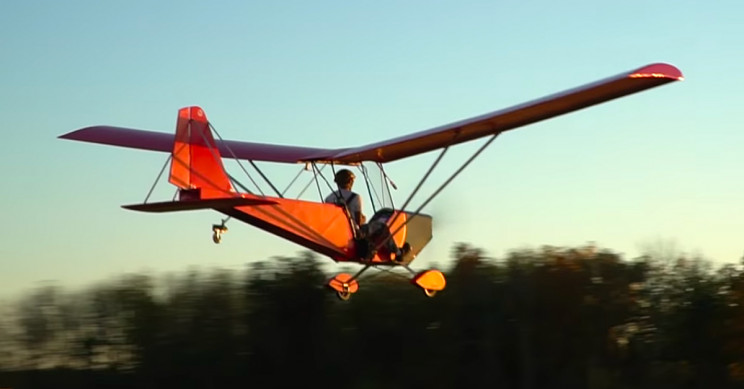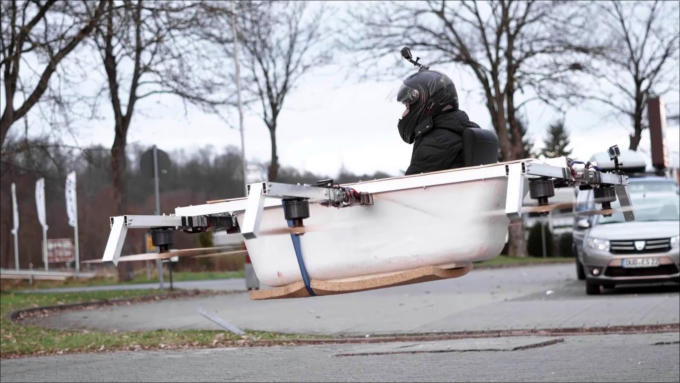Peter Sripol creates interesting ultralight aircraft, among other, sometimes scary projects. His latest is pulled along by a paramotor motor. Because of the small aircraft’s low and slow performance, the low-power (and very low noise) motor seems more than sufficient to the task. His fourth design, the Mk IV has no ailerons, much like an earlier ultralight, the Skypup. After initial tests showed shortcomings with the Mk. IV, quickly modified wings allowed Peter to return to the air quickly. As he explains, there won’t be plans for this airplane because it has too many not as yet time-tested innovations. The hot-wire-cut foam structure and vinyl wrapped wings are an unknown in terms of longevity, so it’s probably best to let Peter make his determination on that. Note the machine seems to be remarkably quiet, the OpenPPG motor drowned out by propeller noise. (That’s also low because of the e-Prop’s design.)* When Peter is able to shout down to his father …
Peter Sripol Groundloops – But Check Out Those Motors!
Peter Sripol is a high-energy model-airplane tester who put a twin-motor electric biplane together out of Home Depot/Lowes parts and flew it successfully. That was a back of the envelope design that flew nonetheless. Peter did something a little more professional for his second go-round, crafting some professional-looking drawings. Don’t look for any drawings for the earlier machine, he cautions, explaining there are none He also wanted a pair of larger, slower turning propellers to move a large volume of air more slowly than the Rotomax 150s installed on the biplane. He notes he’s looking for a lower kV (turns per Volt input). Peter works with Flite Test, a model airplane outfit seemingly willing to try anything. That includes the giant cardboard twin-motored craft shown in the lead image. He apologizes for not being further along on the project, but notes he took time out to build a tank(!) for a video-game client. Let this be a rebuke to those …
When You Wake Up Hungry – Fly to the Bakery!
Electric-Flight.eu reports on three Germans who made a bathtub fly – and used it to fetch pastries. As the website reports, “The Real Life Guys” are two Darmstadt students and one DB train attendant who shook up the media last week . They connected a bathtub with an aluminum scaffolding and six 9.6 [kilowatt] motors (€1 065 or about $1,191[each]) from the model building sector to 42-Volt batteries and blew it up.” “Blew it up” means lifting it skyward on the power of what look like six Hacker model airplane motors, capable of putting out 15 kilowatts (20.1 hp) each for 15 seconds. The 9.6 kW (12.9 hp) output cited in the Electric-Flight article seems realistic for sustained output, and the €1,050 price on Hacker’s website seems to confirm that this is the motor used. That such a device and the idea of actually hopping in and going for a dry run in the sky is daunting gives proof to …
109.5 minutes of Mad Creativity – Ending with an Electric Biplane
Peter Sripol is part of FliteTest, a group that sells electric model aircraft and components and produces some wild and wooly YouTube videos of their exploits. The group’s products are mostly budget items, with simple aircraft quickly constructed the norm. One example, the Simple Solar radio-controlled plane, can be built for under $60, and flies on two coreless motors. Flite Test has quick build kits and FPV (First Person View) radio systems that allow a pilot to view, through an on-board camera, what a (really tiny) person on board the model would see. This level of miniaturization and commodity-level pricing allows FliteTest to provide STEM (Science, Technology, Engineering and Math) kits to schools at the grade and high-school levels. MTV Meets Howard Hughes One of its newest members, Peter has jumped on FliteTest’s seeming willingness to try anything at least once. Putting together extremely large models from foam and tape, it probably was only natural that he would make a …




